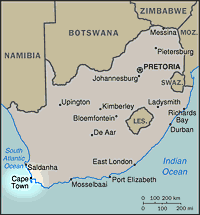 Today, President Clinton begins a three-day visit to South Africa, becoming the first American President to visit South Africa. Major events of his day include: Visit to Victoria Mxenge Housing Savings Scheme
Arrival Ceremony at Tuynhuis
Address to National Assembly at Parliament
Courtesy Call with Speaker of the Parliament Ginwala
Visit to Victoria Mxenge Housing Savings SchemePresident Clinton visits the Victoria Mxenge Housing Savings Scheme, named after Victoria Mxenge (em-KEN-gay), an anti-apartheid lawyer who was assassinated during the anti-apartheid struggle. The scheme now has approximately 280 members, all of whom are women. This is one of nearly 800 savings plans that have been established in South Africa to enable shanty town residents to build and own their own homes. The program's first house was built in 1996 on land donated by the Catholic Church. When the First Lady visited in March, 1997 18 houses had been completed, and the foundation had been laid for the community center. Today there are 104 homes, housing approximately 400 residents. The community center has been completed, and another 44 homes are planes. The Mxenge Scheme has purchased a second plot of land on which it eventually hopes to build an additional 230 homes. The average cost of a home in Victoria Mxenge is 12,000 Rand (approximately $2,400). The members of the savings plan receive assistance from two non-governmental organizations, Peoples Dialogue and The Homeless Peoples Foundation. The National Coordinator for the Federation, Patricia Matolange, was named the South Africa's National Housing Person of the Year in 1996 and 1997. USAID is providing $300,000 two-year grant to the Peoples Dialogue and Homeless People Federation for technical assistance to Victoria Mxenge. The year, USAID is also providing $3,000,000 in grants to South Africa's Ministry of housing and infrastructure development in needy communities throughout the country. Arrival Ceremony at TuynhuisPresident Mandela greets President Clinton in the plaza area in front of Tuynhuis for the arrival ceremony. Following the ceremony President Mandela escorts President Clinton into the National Assembly for the formal address. Tuynhuis [TEN-hAse] is the office and residence of State President Nelson Mandela and one of Cape Town's most important historic buildings. Adjacent to the Houses of Parliament, the original house was built by a Dutch Governor to accommodate distinguished visitors. In the 1790s a subsequent governor erected an elaborate palace to be his official residence. Later, the British transformed the building into a classic imperial Government House. Address to National Assembly at ParliamentPresident Clinton addresses South Africa's National Assembly to discuss the ways in which U.S.-South African relations can be a cornerstone for a new Africa and a model for the continent. South Africa's new democratic parliament consists of two houses: a National Assembly of 400 members and a National Council of Provinces (NCOP) of 90 members. The two houses meet together for special sessions in the National Assembly chamber. The National Assembly is elected by a system of "list proportional representation." Each of the parties appearing on the ballot submits a rank-ordered list of candidates. The voters then cast their ballots for one party. Seats in the Assembly are allocated based on the percentage of votes each party receives. In the 1994 elections, the governing African National Congress (ANC) won 252 seats, the National Party (NP) 82, and the Inkatha Freedom Party (IFP) 43. Four other parties share the remaining seats. The National Council of Provinces replaced the former Senate as the second chamber of Parliament and was created to give South Africa's nine provinces a greater voice in national political deliberations. Each province selects 10 delegates to the National Council of Provinces. The delegates are appointed by the parties represented in the provincial legislature on a proportional basis. Normally, the provincial Premier heads the delegation to the Council. It must approve legislation that involves shared national and provincial jurisdiction as defined by an annex to the 1997 Constitution. The Parliament complex is located in one of Cape Town's most historic districts. Built in high Victorian style, the main Parliament building was completed in 1885. When the Union of South Africa was formed in 1910, it became the seat of the national parliament. In front of the building is a marble statue of Queen Victoria, erected in honor of her golden jubilee. Courtesy Call with Speaker of the Parliament Ginwala
Parliament Building President Clinton meets with the Speaker of the National Assembly, Dr. Frene Ginwala of the ANC, the first woman to serve as Speaker. The meeting takes place in the boardroom of the Speaker of the National Assembly. Leaders of the Parliamentary opposition, or possibly national leaders of opposition parties, will be present. The following parties are represented in the 400-member National Assembly: African National Congress (252 seats), National Party (82), Inkatha Freedom Party (43), Freedom Front (9), Democratic Party (7), Pan Africanist Congress (5) and the African Christian Democratic Party (2). Patrick Lekota, the chairman of the National Council of Provinces, which together with the National Assembly composes Parliament, may also be present. | 
